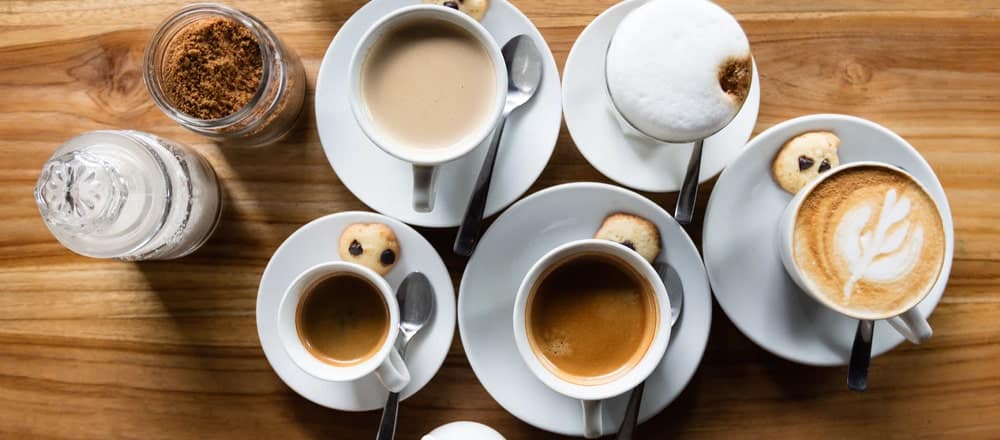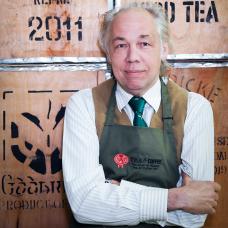Types of Coffee Drinks

Deciding which types of Coffee drinks you’d like off a cafe blackboard can be a daunting experience. There is so much in the way of choice these days, so many varieties you’ve never heard of or even thought were a “thing.”
Where do you start? You begin by reading the following article to understand your options better. In doing so, you’ll be able to walk into that cafe with confidence.
We’ll keep things easy at first with the most popular types of Coffee drinks available. Once you’ve got your head around those, we’ll move on to a couple of lesser-known choices.
The alternative is to buy Fresh Coffee Beans from us here at The Kent and Sussex Tea and Coffee Company. Ultimately, whatever you decide, we’ll help you through the process in the clearest and most concise way possible.
Table of contents
- What Types of Coffee Drinks are Most Popular?
- Cappuccino is the King of Coffee
- Latte is a Competitive Cuppa
- Americano is the Red, White and Blue Choice
- Choose Espresso if You Need a Boost
- Flat White Coffee Comes from Australia or New Zealand?
- Macchiato is for Those Who Like Less Milk
- Feel Cool with Cold Brew Coffee
- Iced Coffee is on the Rise
- Lesser Known Coffee Drinks
- Conclusion

What Types of Coffee Drinks are Most Popular?
You could walk into a Coffee shop in Somerset or Sydney, and you’d still see at least some of the same. In other words, regardless of where you are in the world, be it England or Australia, there are types of Coffee drinks that are popular everywhere.
But what, exactly, are they? And what makes them so sought-after among casual consumers and connoisseurs alike?
The ones you’re most likely to see on the blackboard of any cafe or restaurant are cappuccinos, lattes, americanos, espressos and flat whites.
Others such as macchiatos, cold brew Coffees and Iced Coffee (we’ll explain the difference between these two later) are becoming increasingly well-known, so we’ll include them here. What makes each one so great is as follows.

Cappuccino is the King of Coffee
When most people think of barista-style Coffee, thoughts often drift to cappuccino. This is a beverage consisting of ⅓ espresso, ⅓ steamed milk and ⅓ foamed milk. The equal measures of ingredients produce a well-balanced flavour and texture best described as bold and somewhat sweet.
It is perhaps no surprise that the cappuccino ranks high – if not highest – among all the types of Coffee drinks.
The name “cappuccino” originates from the colour of the brew, specifically its similarity to the brown colour of the habits (i.e. clothes) of Capuchin friars.
Food historians believe that an early version of it, known as a “kapuziner,” was created by the Viennese during the 18th-century. However, the history of the modern-day cappuccino comes from Italy in the 1930s.

Latte is a Competitive Cuppa
If cappuccino is the king, then a latte is the Coffee next in line for the throne. Some would argue, in truth, that it is the true king (or queen!).
This is another example of an espresso Coffee (more on this term later). Specifically, it consists of ⅙ espresso, ⅔ steamed milk and ⅙ foamed milk. It does, indeed, share many similarities to cappuccinos – the primary difference between the ratio of ingredients.
The first appearance of the term “caffe e latte” was in William Dean Howells’ 1867 essay, “Italian Journeys.”
However, most would agree that the creation of the latte we know and love today happened in Seattle, Washington State, USA, during the 1980s. Seattle is still home to a thriving Coffee industry, with the latte leading the way compared to other types of Coffee drinks.

Americano is the Red, White and Blue Choice
It probably goes without saying that “Americano” means “American.” The word derives from American-Spanish and dates back to the 1970s.
The Coffee itself is again an espresso, although that’s where its similarities to cappuccinos and lattes end. This is instead an infusion that dilutes espresso with hot water, producing a brew akin to filter Coffee in strength but not in taste.
Also unlike lattes and cappuccinos, the history of the americano is a relative mystery. One story is that it dates back to the Second World War (1939-1945) when American G.I.s based in Italy diluted espresso in the above manner.
Whether there is any truth to the tale remains uncertain. Regardless, the americano – an unmistakably bold and powerful choice – has long been associated with the United States.

Choose Espresso if You Need a Boost
An espresso (pronounced “ess-PRESS-oh” and NOT “ex-PRESS-oh”) refers, for the most, to the process applied to its creation. It isn’t necessarily a type of Coffee drink.
Rather, it is the product of forcing pressurised hot water through finely-ground Coffee. This is also known as “pulling a shot” – and a shot of espresso is, in essence, a concentrated form of dark roasted coffee beans.
Are you still a little confused? That’s okay. Basically, you can have an espresso as a single (or double) shot, which is what many people would see on a menu.
It is this same sort of shot, however, that finds its way into the likes of cappuccinos, lattes and americanos. The shot alone, some would argue, is one of the types of Coffee drinks, while its inclusion in other beverages is where it becomes a process.

Flat White Coffee Comes from Australia or New Zealand?
A Flat White is comparable to a latte in several ways. It is an espresso (surprise, surprise) adorned with steamed milk but with one distinct difference: microfoam.
This, too, is steamed milk except it has undergone a process whereby baristas gently infuse it with air. The result is silky, textured milk containing tiny air bubbles, which are barely visible to the drinker when made well.
Interestingly, if somewhat contentiously, few people appear to agree on whether the Flat White came from Australia or New Zealand.
One story suggests that it was Alan Preston, a Sydney cafe owner, who coined the term after hearing fellow Australians ask for “White Coffee – flat.”
Yet Frank McInnes, a Kiwi, claims that he accidentally invented it after botching a cappuccino. We’ll likely never know for sure.

Macchiato is for Those Who Like Less Milk
A Macchiato isn’t as well known as a cappuccino, but it still has enough renown to make it into our list of popular types of Coffee drinks. The term “macchiato,” translated from Italian, means “stained” or “marked.”
In this context, it refers to a shot of espresso “stained” or topped with a small amount of foamed or steamed milk. It is an excellent choice for those who find a straight shot too strong.
There is little in the way of an origin story for the macchiato. What seems to be the case is that baristas created the name in order to differentiate between straight espresso and espresso with milk.
There is also a latte macchiato, it’s worth noting, which, as its name suggests, is similar to a latte except that it has more milk and less espresso.
Both of these types of Coffee drinks are rising ever-higher on the blackboard.

Feel Cool with Cold Brew Coffee
It pretty much says it all in the name: Cold Brew Coffee. This is one of the few types of Coffee drinks that requires exceptional patience, due mostly to it taking up to 12 hours to make!
The way it works is by steeping coarsely ground Coffee beans in room-temperature water for around half a day. Such a method results in a Coffee concentrate you mix with more cold water or milk.
Cold Brew lovers believe that it tastes smoother than Iced Coffee (more on the differences between the two in a moment). It is also great for those who’re sensitive to acidity, with research indicating that Cold Brew Coffee is 67% less acidic than a hot cuppa.
The practice might (emphasis on “might”) originate from Kyoto, Japan, during the 17th-century. What is certain is that Cold Brew Coffee has much to offer.

Iced Coffee is on the Rise
You’re probably wondering, “What’s the difference between Cold Brew Coffee and Iced Coffee?” You’d be right to ask, too, as on the surface it would seem to be two sides of the same coin.
Except it isn’t. The primary distinction is that Iced Coffee is brewed hot and served cold. In other words, you chill hot Coffee by either refrigerating it for a few hours or pouring it over ice – much like Iced Tea Recipes.
The first example of a beverage made in this style is that of the Maragran – a cold, sweetened Coffee from Algeria popularised in the 19th-century.
Western countries caught on to the trend during the 1920s, although it wasn’t until recently that it took the world by storm.

Lesser Known Coffee Drinks
There are, of course, dozens of types of Coffee drinks available in cafes and restaurants globally. Some you would’ve heard of and indeed have tried.
Others might be unknown to you by taste or even name. Take Mocha, which only narrowly missed being included in the above section. This infusion is a mixture of espresso, hot milk and chocolate powder (not to be confused with our Mocha Coffee Beans).
Another lesser-known variety is the Lungo, which is essentially a shot of espresso with more water to make a “regular” sized beverage.
Red Eye Coffee, too, is relatively unfamiliar but nevertheless delicious. It consists of brewed Coffee topped off with an extra shot of espresso.
Finally, we’d like to introduce you to Irish Coffee, a cocktail that uses hot Coffee, Irish whiskey, sugar and cream – a match made in heaven.
Conclusion
There is one Coffee (well, arguably seventy) we’ve so far forgotten to mention. If you’re a traditionalist who enjoys the taste of your cuppa unhampered by fancy milk or creme, then look no further than here.
The Kent and Sussex Tea and Coffee Company stocks an expansive range from Coffee Blends to Flavoured Coffee to Decaf. Why not start exploring today, you can buy coffee online from our online stoere.

 Loose Leaf Tea
Loose Leaf Tea Pyramids
Pyramids Tea Bags
Tea Bags Africa
Africa Assam
Assam Ceylon
Ceylon Chinese
Chinese Darjeeling
Darjeeling European
European Indian
Indian Japan
Japan Nepal
Nepal South East Asia
South East Asia Ayurveda Tea
Ayurveda Tea Black Tea
Black Tea Chai Tea
Chai Tea Flowering Tea
Flowering Tea Fruit Tisanes
Fruit Tisanes Green Tea
Green Tea Herbal Tea
Herbal Tea Matcha Tea
Matcha Tea Oolong Tea
Oolong Tea Organic Tea
Organic Tea Pu erh Tea
Pu erh Tea Rooibos Tea
Rooibos Tea White Tea
White Tea Asian Coffee
Asian Coffee Caribbean Coffee
Caribbean Coffee Central American Coffee
Central American Coffee South American Coffee
South American Coffee Coffee Blends
Coffee Blends Decaffeinated Coffee
Decaffeinated Coffee Espresso Coffee
Espresso Coffee Ethically Sourced Coffee
Ethically Sourced Coffee Flavoured Coffee
Flavoured Coffee Organic Coffee
Organic Coffee Single Origin Coffee
Single Origin Coffee Chocolate 1
Chocolate 1 Chocolate 2
Chocolate 2 Chocolate 3
Chocolate 3 Chocolate 4
Chocolate 4 Chocolate 5
Chocolate 5 Chocolate 6
Chocolate 6 Chocolate 7
Chocolate 7 Chocolate 8
Chocolate 8 Chocolate 9
Chocolate 9 Loose Tea Filters
Loose Tea Filters Tea Accessories
Tea Accessories Tea Bricks
Tea Bricks Tea Caddies
Tea Caddies Tea Caddy Spoons
Tea Caddy Spoons Tea Gift Ideas
Tea Gift Ideas Tea Infusers
Tea Infusers Tea Strainers
Tea Strainers